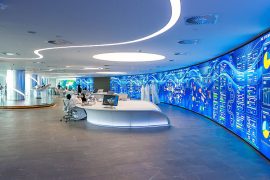Technology transformations are inevitable and disruptive across all the industries, and the real estate industry is no exception. Real estate sector is a vital indicator of infrastructure and development. The role of technology in real estate has helped in solving problems in every pipeline of the real estate division, spearheaded faster development. with increased efficiency and effectiveness over a few decades.

Architectural Design
2D & 3D Design
The real estate industry started with the traditional 2D sketch plans in paper format. Drawing, editing and managing these charts were complicated. The real estate customers had a hard time visualizing these designs and did not know how the plan is going to be developed as a project. The computer-aided design(CAD) softwares have made the task of design a breeze. An architect can provide architectural dimensions in this software and render the output in image formats or video formats. These outputs can be used for presenting the clients and customers are no longer feeling lost with the design. Some of the software used for architectural rendering are AutoCAD, 3DS MAX, Revit, etc. These softwares are capable of developing 3D objects based on the 2D drawings.
Some of the real estate companies prefer to
• Develop their design software
• Outsource these design and visualization to other companies
These designs are available online, and customers can view them from their mobile/computers. The process reduces the approval time and has greater customer satisfaction.
Sales and marketing
Digital marketing
Customers are no longer interested in physically visiting real estate service provider and looking for best-suited projects. The real estate companies are investing high in digital marketing to find leads and customers. They collaborate with reputed digital marketing companies for getting qualified sales leads.
Contact support@e-orchids.net to know more about our digital marketing services.
Chatbots
Chatbots are efficient interaction points with a potential prospect or customer. When a lead is visiting a real estate providers website, a chatbot can ask to handle straightforward queries that a customer may request. It also can provide standard information on projects, images, and videos without any human interference. The ability of the chatbots to work 24 * 7 * 365 and assist prospects to fill in contact forms, get in touch with a sales agent or schedule a visit helps in reducing the overhead cost of sales and marketing team.
Survey
The qualified leads are followed up with various surveys to recommend best suited real estate projects. These surveys help in reducing discussion and approval time. The companies can do better customer segmentation and hence build an efficient sales and prospects pipeline. The surveys tool can be automated to send a survey at the required time frame.
Click here, for a one month free trial on our survey tool.
Virtual reality and Augmented Reality
Some softwares are capable of producing direct outputs to other virtual & augmented reality platforms and tools. Both VR & AR provides the potential to visualize a property/apartment even before completion. VR can view the interior, exterior and floorplan of the property, alter the layout and furniture placement, etc. Custom softwares can auto render the design to 3D outputs which can be accessed by the customers instantly. AR & VR allows the developers to sell projects/apartments even before project completion. These features are a boon to customers who cannot be physically present or looking for investment across geographies.
Have a look at our AR & VR solutions for real estate projects.
http://hexaplans.com/panorama/index.html
http://hexaplans.com/360/index.html
Planning
Plot and Impact analysis
Architects use specialized AR gears to collect data of the plot(height, depth, width, etc.) to plan their procurement. This data is also used to assess the impact of the surrounding on the building, both society and environmentally.
Team Co-ordination
A real estate project involves co-ordinated work between various teams. It is critical to ensure that procurements are done promptly to complete project on time. With conventional co-ordination approach, if there is a change in plan design, it takes a considerable amount of time to manually change the procurement list. Technology has eased this task with softwares that are capable of updating the procurement list instantly and help in co-ordinating task across various teams in real time between the groups and stakeholders, track the progress, costing, scheduling and payment.
These softwares are capable of reducing
• The coordination burden
• Minimizing order change
Moreover, once the project gets completed, the change data can be used by facilities management companies to track in the future.
Construction
Modular construction
Real estate projects often involve problems due to weather, construction time, material wastage and safety hazards. These problems can be eliminated by a module based approach where prefabricated materials are constructed in another location(off-site). Later, these materials are transported to the site and assembled.
Modular construction helps in
• Better design
• compact & safer construction
• lesser material wastage,
• disassembly
• Material reuse
3D printing
The usage of robotics with 3D printing technology is increasingly popular for on-site construction. 3D printing is also called additive manufacturing where three-dimensional shapes are constructed with material layering. These materials are layered with assistance from Computer-aided design softwares. Variety of materials such as cement or liquid are used and can be printed in multiple colors too. In combination with dissolvable materials can aid subtraction of materials which reduces cost, labor, and wastage.
Robotics
Robotic arms may be used in the construction industry in the future to lay bricks leading to quicker turnaround time with higher precision.
Monitoring
Drone and UAVs
Construction progress is monitored using drones and UAV(Unmanned Airborne vehicles) in realtime and accurate data is captured by photos and videos right from the starting phase to completion phase.
The captured data is
• Communicated across all the stakeholders
• Helps in real-time decision making
thereby increasing the overall efficiency during the construction phase.
Asset Management
Property Managemet software
Management of assets can be done using property management softwares. They are used to track and monitor the
• Performance of the building equipment
• Manage daily tasks carried out by maintenance teams
• Record downtime.
• Rent cycles
• Vacancy cycles
Hence, these PMS softwares helps in the better and efficient process
Check out our Project management software trial. Call us for a Free Demo
Robotics
Robots are used to automate mundane daily activities like cleaning homes and other common building areas. These robots can be controlled from anywhere by changing its direction with the help of a mobile app.
Facility Management
Smart devices
High energy consumption and weak security concerns are a significant area of focus across real estate companies world over. The power to integrate
• Smart energy meter
• Smart lights
• Smart thermostats
• Smart appliances
• Smart security system
to single source control has solved a wide variety of problem for real estate companies. The smart devices can control the energy consumption and manage the facilities of real estate properties distributed wide across the globe from a single point. They are also capable of picking up the energy usage pattern and execute on a daily basis. The smart devices enable the real estate companies to predict the future energy usage and plan accordingly.
The increasing use of technology has proven great benefits to the real estate industry.





Comments are closed.